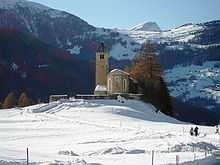Lantsch/Lenz
| Lantsch/Lenz | ||||||||||
|---|---|---|---|---|---|---|---|---|---|---|
 | ||||||||||
| ||||||||||
| Population | 543 (Dec 2012)[1] | |||||||||
| - Density | 25 /km2 (64 /sq mi) | |||||||||
| Area | 21.81 km2 (8.42 sq mi)[2] | |||||||||
| Elevation | 1,328 m (4,357 ft) | |||||||||
| Postal code | 7083 | |||||||||
| SFOS number | 3513 | |||||||||
| Surrounded by | Alvaneu, Alvaschein, Arosa, Brienz/Brinzauls, Vaz/Obervaz | |||||||||
| Website | www.lantsch-lenz.ch SFSO statistics | |||||||||
 Lantsch/Lenz | ||||||||||
| Location of Lantsch/Lenz
 | ||||||||||
Lantsch/Lenz (German: Lenz, Romansh: Lantsch) is a municipality in the district of Albula in the canton of Graubünden in Switzerland.
The majority of its population is Romansh-speaking.
History
Lantsch/Lenz is first mentioned around 850 as Lanzes.[3]
Geography

Lantsch/Lenz has an area, as of 2006, of 21.8 km2 (8.4 sq mi). Of this area, 27% is used for agricultural purposes, while 34.4% is forested. Of the rest of the land, 3.8% is settled (buildings or roads) and the remainder (34.8%) is non-productive (rivers, glaciers or mountains).[4]
The municipality is located in the Belfort sub-district of the Albula district. It is located at an elevation of 1,294 m (4,245 ft) on a terrace above the right side of the Albula river. It consists of the linear village of Lantsch/Lenz. Until 1943 Lantsch/Lenz was known as Lenz.[5]
Demographics
Lantsch/Lenz has a population (as of 31 December 2012) of 543.[1] As of 2008, 12.5% of the population was made up of foreign nationals. Over the last 10 years the population has grown at a rate of 1.5%. Most of the population (as of 2000) speaks German (54.2%), with Romansh being second most common (36.7%) and Albanian being third ( 2.5%).[4]
As of 2000, the gender distribution of the population was 51.6% male and 48.4% female.[6] The age distribution, as of 2000, in Lantsch/Lenz is; 49 people or 10.1% of the population are between 0 to 9 years old. 32 people or 6.6% are 10 to 14, and 29 people or 6.0% are 15 to 19. Of the adult population, 36 people or 7.4% of the population are between 20 to 29 years old. 76 people or 15.7% are 30 to 39, 66 people or 13.6% are 40 to 49, and 61 people or 12.6% are 50 to 59. The senior population distribution is 56 people or 11.5% of the population are between 60 to 69 years old, 61 people or 12.6% are 70 to 79, there are 16 people or 3.3% who are 80 to 89, and there are 3 people or 0.6% who are 90 to 99.[7]
In the 2007 federal election the most popular party was the CVP which received 38.9% of the vote. The next three most popular parties were the SVP (33.2%), the SPS (16.2%) and the FDP (10.8%).[4]
The entire Swiss population is generally well educated. In Lantsch/Lenz about 73.7% of the population (between age 25-64) have completed either non-mandatory upper secondary education or additional higher education (either university or a Fachhochschule).[4]
Lantsch/Lenz has an unemployment rate of 2.24%. As of 2005, there were 24 people employed in the primary economic sector and about 9 businesses involved in this sector. 25 people are employed in the secondary sector and there are 5 businesses in this sector. 83 people are employed in the tertiary sector, with 31 businesses in this sector.[4]
The historical population is given in the following table:[3][6]
| year | population |
|---|---|
| 1710 | 215 |
| 1850 | 353 |
| 1900 | 363 |
| 1950 | 355 |
| 1960 | 366 |
| 1970 | 373 |
| 1980 | 382 |
| 1990 | 453 |
| 2000 | 485 |
Heritage sites of national significance

St. Mary's Church in Lantsch/Lenz is listed as a Swiss heritage sites of national significance.[8]
References
- ↑ 1.0 1.1 Swiss Federal Statistics Office – STAT-TAB Ständige und Nichtständige Wohnbevölkerung nach Region, Geschlecht, Nationalität und Alter (German) accessed 16 September 2013
- ↑ Arealstatistik Standard - Gemeindedaten nach 4 Hauptbereichen
- ↑ 3.0 3.1 Lantsch/Lenz in German, French and Italian in the online Historical Dictionary of Switzerland.
- ↑ 4.0 4.1 4.2 4.3 4.4 Swiss Federal Statistical Office accessed 24-Sep-2009
- ↑ Amtliches Gemeindeverzeichnis der Schweiz published by the Swiss Federal Statistical Office (German) accessed 23 September 2009
- ↑ 6.0 6.1 Graubunden in Numbers (German) accessed 21 September 2009
- ↑ Graubunden Population Statistics (German) accessed 21 September 2009
- ↑ Swiss inventory of cultural property of national and regional significance 21.11.2008 version, (German) accessed 24-Sep-2009
| Wikimedia Commons has media related to Lantsch/Lenz. |
External links
 Media related to Lantsch/Lenz at Wikimedia Commons
Media related to Lantsch/Lenz at Wikimedia Commons- Official website (German)
- Lantsch/Lenz in German, French and Italian in the online Historical Dictionary of Switzerland.
| |||||||
